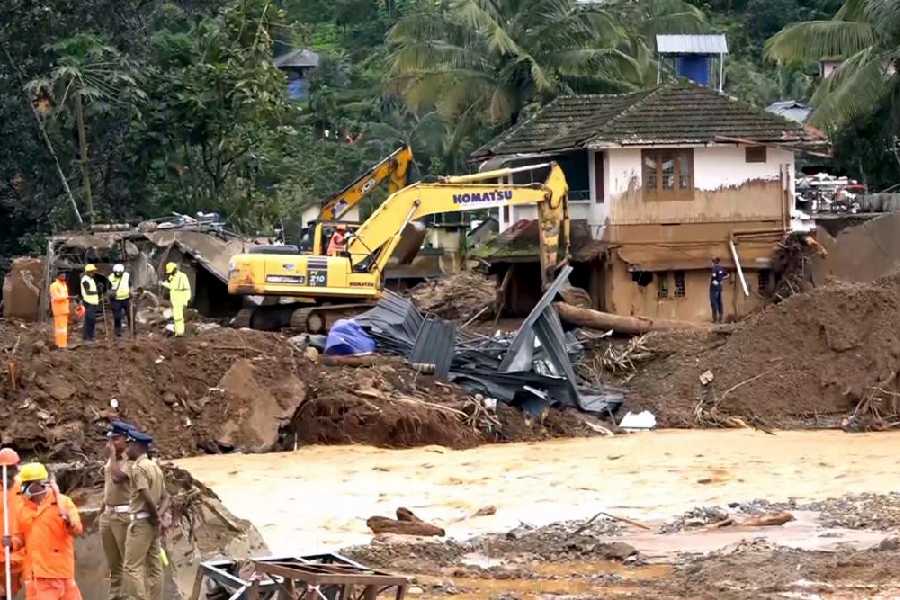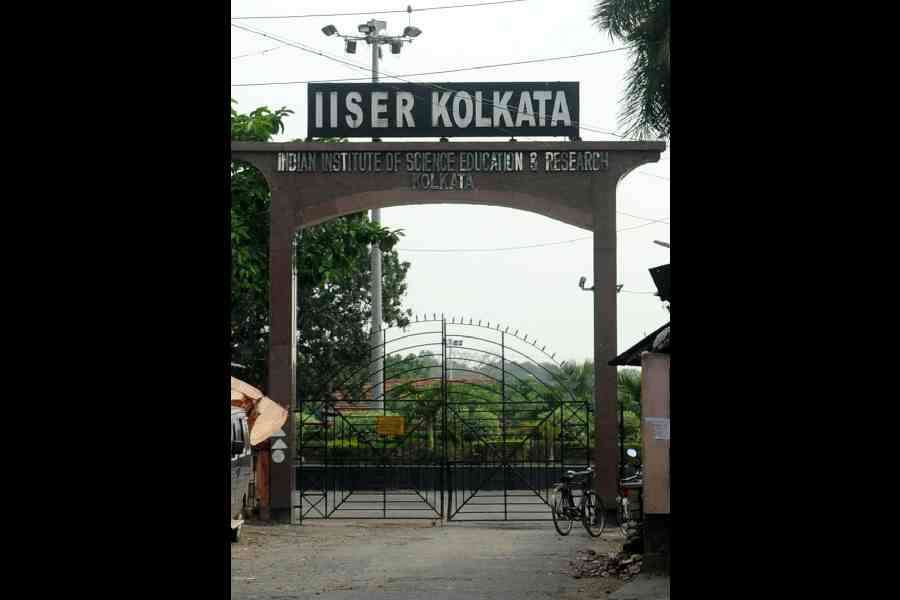.jpg)
near the Golaghata footbridge. Pictures by Saradindu Chaudhury
Look outside your window and chances are that you’ll see a tall tree but bereft of leaves. Its thin branches look like the ominous fingers of a witch and its trunk is a ghostly white.
No, it's not Halloween but World Environment Day. But instead of green, Salt Lake is wearing white.
Hundreds of trees, particularly Sirish (Albizia lebbeck), are dying. The phenomenon has been noticeable for a few months now and the forest department believes that they are under the attack of some insects. But investigation is on and officials are not ruling the possibility of a racket out to kill the trees and sell its precious lac either. Lac is the scarlet resinous secretion of several species of lac insects which are known to attack trees.
Green no more
.jpg)
The trunks of the dying trees start going white, beginning at the bottom and soon spreads to the branches. The bark peels off and several tiny holes appear on the trunks.
“We noticed this tree’s branches turning white last year,” says Kamal Mandal, a resident of AG Block, pointing at a dead Sirish tree opposite the Kathgola Island. “After a couple of months, the branches turned red and a sticky substance started oozing out. Scores of people came and hacked off entire branches.”
Another dead Sirish tree stands by the road leading to Baisakhi. Government employee Bablu Chakraborty says he saw it dying. “I had planted this tree myself in 1984 but now it’s dead. Six months ago it suddenly turned white after which some people came and collected the sticky substance that was oozing out. They also broke all the branches and took them away,” said Chakraborty.
The Sirish has an average life span of 70 years. A full-grown tree absorbs 28.5 tons of carbon dioxide annually, as per a study by the School of Forestry of the Bogor Agricultural Institute, Indonesia. It has medicinal properties, is suitable for making furniture but is most precious for the costly lac that oozes out after the tree dies. The timber of a sick and dead tree will not have much worth in the market.
A retired forester, Satyananda Das, says he saw the problem first hand at the Royal Calcutta Golf Course. “A minuscule insect called Kerria Lacca spells doom for these trees as they latch on, multiply at a rapid pace and suck the tree dry. Without any nutrients to sustain itself the tree eventually dies. This particular species of insect is reared in Purulia, Bagmundi, Jharkhand and Chattisgarh for the production of lac,” he says.
Deathly hallows
Sirish trees are dying dime a dozen all over the township. Of the six trees inside the Sarat Mancha Park opposite Sarat Abasan in Baisakhi, two are dead and two more are dying. On the pavement adjacent to Sarat Abasan’s park, near the old site of the East police station, two more trees have turned a ghostly white and cut an eerie picture.
Three trees stand lifeless near FE Park and a small sawn-off stub lies abandoned on the ground adjacent to the boundary wall of the Bidhannagar Municipality School’s park.
.jpg)
The stretch near Anindita Island, opposite HA Block, has been beautified recently and features sculpture and shrubbery but the centrepieces are three dead trees. These trees do not fall off easily after dying because of their deep network of roots.
On a stretch opposite Falguni housing complex are seven dead trees, some of them chopped off, standing as silent sentinels on the pavement.
Perhaps the highest number of dead trees is on the canal side road from AB Block to Baisakhi. As many as 35-odd trees have perished here and only their ghostly white trunks and branches loom over the otherwise green stretch.
“I had heard that a few years back some advertisement agencies had killed trees on VIP Road to make way for billboards. I fear that they might have done it again,” said Saptarshi Ray, an advocate residing in SA Block.
The VIP Road side of this stretch is just as bad, if not worse. As many as 31 trees have died on the 2 km-long stretch from Kestopur to the Ultadanga flyover and four dead trees stand less than 20m away from the Dum Dum Park beat office of the forest department’s urban recreation forestry division.
Officialspeak
Officers of the forestry division are aware of the problem.
“Ninety per cent of the dead trees are Sirish. Most of them were planted during a plantation drive in the 1970s,” said a source at the Dum Dum Park forest department beat office.“Sirish has great commercial value. Its sap is used to make gum and a chemical that is used for polishing wood. Its wood is used to make furniture and the plant also has medicinal values. It is effective against poisonous bites and is used to treat several ailments. But the main reason we grow Sirish here is because they grow easily,” he says.
Another senior officer believes the trees are getting attacked by insects. “A team of experts from the Botanical Survey of India collected several samples a few months ago to ascertain why the trees were dying. The report hasn’t been submitted yet but it seems that this is being caused by some kind of insect that particularly targets Sirish trees,” said the officer.
.jpg)
The forest department is also probing if this is a racket. “That’s because we have seen people swarming the area, chopping off branches and stripping the bark off the trees as soon as they die,” the officer added. “We have even chased and caught some of these people, who confessed to be stealing the lac. It is possible that they purposely latch the insects on to the trees and wait for them to die.”
Green activist Subhas Dutta suspects foul play. “The VIP Road stretch is always in the news for dying trees. I suspect that the people in charge of protecting these trees are hand-in-glove with the miscreants who are killing these trees to extract lac.”
A fully-grown Sirish tree covers a large area with shade and can absorb a large amount of carbon dioxide that is instrumental in keeping Calcutta’s air pollution levels low, says Dutta. “These trees also form a natural habitat for a host of birds and small animals like squirrels. As more and more trees succumb, ecological balance will be damaged.


Krishnajyoti Goswami
Consultant biochemist
Stays in: Cluster XIII, Purbachal
Does development have to come at the cost of precious greenery? Any sensible person would say no. But that’s exactly how rampant deforestation is going on in my neighbouring blocks GA, HA and IA, knowingly or unknowingly.
About 25 trees in the area were destroyed or killed with help of copper sulphate solution and asafoetida and then cut off. Initially they turned white and, within a short time, died.
In our city, greenery plays a pivotal role in improving urban environment, by preserving water and soil, controlling temperature and humidity of air and preventing pollution. But compelled by our greedy and consumptive nature, we have forgotten its essentiality as a partner in our lives.
The destruction of greenery in Salt Lake has also led to a loss of biodiversity. We are all aware of recent temperature rises and are always discussing the effects of global warming. We all know that if a tree has to be felled for any specific reason, we must plant 10 more trees in lieu of that tree. This will help not only us but our future generation as well.

But in practice, we are subsidising the destruction of the environment with the excuse of aiding technology.
When we chop down trees, we are destroying a natural resource of oxygen. Traffic load is increasing day by day in our city and the amount of oxygen is getting depleted due to the heavy amounts of pollutants emitted by vehicles. The Metro Railways development workshop, also in this area, is polluting the air every single day. The trees that are present here are not sufficient to recycle that polluted air back into oxygen and instead in many highly polluted areas the trees are dying due to excess amount of smog in the air.
Thus, the rapid destruction of the urban greenery from the township’s environs is affecting the urban ecology and causing environmental degradation.
If we do not intervene in time, there will come a day when there will be no green left at all to rescue and recycle, and that will be doomsday for us as well.
(Krishnajyoti Goswami is director, National Referral Centre for Lead Projects in India, West Bengal)
Have you seen a tree dying in your neighbourhood?
Write to saltlake@abpmail.com or
The Telegraph Salt Lake, 6, Prafulla Sarkar Street, Calcutta 700001

.jpg)








